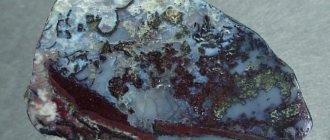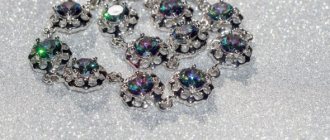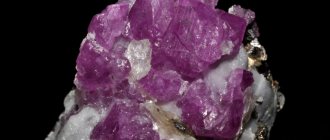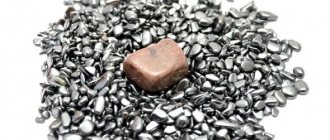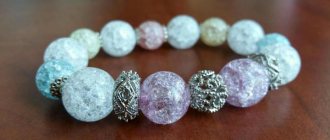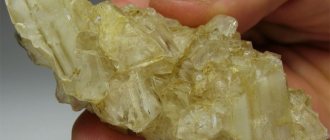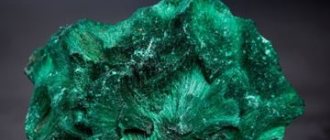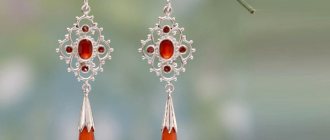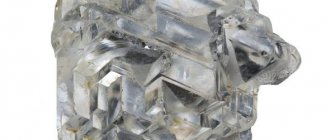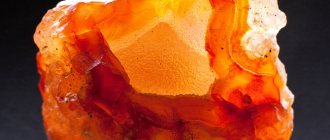- Which: Precious;
- Deposits: Labrador Peninsula (Canada), USA, Mexico, Finland, India, Madagscar, Ukraine;
- Colors: Gray to almost black with multi-colored tints;
- Mohs hardness: 6-6.5;
- Transparency: Opaque;
- Density: 2.7 g/cm³;
- Formula: (Ca, Na)[(Al, Si)AlSi2O8];
- Who is suitable according to their zodiac sign: Everyone, but there are rules;
- How much does it cost: from 5 dollars.
Labradorite is a gemstone that is obtained from the mineral of the same name through special processing. The colors of Labradors can be blue, purple and dark green.
Its main secret is a beautiful iridescent glow in bright light (scientists call this effect iridescence).
Labradorite stone goes well with almost any clothing, and some people believe that it has healing and magical properties.
Origin story
According to legend, the Hyperboreans were the first to use Labradorite. In the era of antiquity and the Middle Ages, the labradorite stone was practically unknown (although there were many legends about the mysterious jewels of the East).
However, in 1770, large deposits were discovered on the Labrador Peninsula, which is located in modern Canada, and the gem itself became very popular in Europe.
Also, small deposits were discovered in Russia, after which they began to make jewelry, snuff boxes, and so on from Labradorite stone.
Place of Birth
Most of the stone deposits are concentrated in Ukraine and Russia. It is also mined in Canada, America, and Finland.
Labradorite is a mineral with a wide range of shades. It is curious that each deposit has its own characteristics of this stone. They differ in color. In Finland, the mineral is mined with a bright indigo hue, in China - blue, in Norway - blue, in Australia - dark shades.
There is a fairly large reserve of this gem throughout the world. Despite this, labradorites are highly valued. Not everyone can buy jewelry with this stone.
Since nature has reserves of large solid stones, labradorite is traditionally used to build buildings and use it for interior decoration.
Natural deposits of the mineral may differ in shape:
- lopolit – has the shape of a saucer;
- laccolith - in the form of a depression, pit;
- rod - column;
- dike - stone wall.
Main varieties
There are the following types of Labrador:
Black lunar
This variety has a characteristic blue or bluish sheen in bright light. It is widely used in jewelry, and most jewelry is made from stones of this type.
Solar
It is mined in the USA, and its characteristic feature is its bright yellowish-golden and even white color.
Spectrolite
In the light it shimmers with all the colors of the rainbow. This type of stone was discovered in 1940, and the production of jewelry with spectrolites began after World War II.
Description of the stone
Labradorite or labradorite is a representative of numerous types of feldspar. Its structure contains sodium calcium, a silicate with aluminum segments. The color palette is varied: it includes all the colors of the rainbow when shimmering in the light. A limited number of natural crystals have a similar property. This is a unique, irreplaceable characteristic, especially valued in situations where the nugget is used for exclusive finishing or to create truly original design effects.
Labradorite or labradorite?
Labradorite
In many European countries, labradorite is called labradorite. This often leads to confusion because labradorite is also a name for an igneous rock that is somewhat similar in appearance and some physical properties to labradorite.
Here you need to understand that labradorite differs from labradorite in composition, physical and medicinal properties, therefore it is wrong to equate these minerals.
How to wear and care for a Labrador
Labrador is perfect for business style. An absolutely white shirt will look very good with neat small earrings containing a gem. This approach will create a seductive image, discreet and intellectual.
A long evening dress combined with a shimmering mineral will cause a sensation. You can use a massive necklace, a set of crystal jewelry or a sophisticated pendant. In order for your Labrador to always shine with its beauty and strength, it is important to properly care for it.
The nugget reacts to the effects of acids; for this reason, resorting to chemicals to clean the crystal is undesirable. It is best to rinse your Labrador under the tap with running water. The nugget requires regular polishing. To do this, you can use a soft brush or cloth. Polishing will bring out the shine and shimmer of the crystal.
It is best to store the gem in a separate box with soft upholstery. Although the mineral is resistant to temperature changes, it should not be exposed to this. It is advisable to charge the Labrador with moonlight from time to time.
Physical properties
Labradorite stone has the following physical characteristics:
- Consists of 50-70% CaAl2Si2O8 and 30-50% NaAlSi3O8. May contain small impurities of iron, manganese and magnesium.
- Color - dark gray, smoky gray and completely black. In the light it has characteristic blue, cyan, blue-green and multi-colored iridescence (depending on the stone) due to a phenomenon called iridescence. It should be remembered that iridescence appears only after polishing, and untreated Labradorite stone looks uninteresting and does not shine.
- Opaque,
- Does not luminesce.
- Soluble in acids.
- It crumbles and is easily crushed upon impact.
- It has a triclinic system.
- Density is about 2.7 grams per cubic centimeter.
- Hardness – 6 – 6.5 units on the Mohs scale.
- The average crystal size is about 5-10 centimeters; crystals larger than 50 centimeters are extremely rare.
Physico-chemical properties of labradorite
Ornamental labradorite is classified as feldspar; in the depths it is found both as inclusions in rocks and as solid crystalline blocks.
Labrador is most often gray to almost black with multi-colored tints. The stone is opaque and has medium hardness - up to 6.5 on the Mohs scale. It has an exceptionally bright iridescence (plays and shimmers with all the colors of the rainbow), which is also called labradorization.
When a stone is compressed under high pressure, labradorite crumbles, and with a strong impact it can even split.
Gemologists distinguish several main types of Labradorite.
Diagnostic signs
Similar minerals . Anorthoclase.
Satellites. Olivine, pyroxenes, chromite, ilmenite, chalcopyrite, pyrrhotite, pentlandite, hypersthene, amphibole, magnetite, anorthoclase, sanidine, etc.
Magical and healing properties
Labradorite has the following healing properties:
- Helps with infertility, impotence and some other diseases of the genitourinary system.
- Relieves pain in joints and spine.
- Relieves headaches and can slightly reduce the temperature of a cold (by 0.3 - 0.6 degrees).
- Can be used to prevent cancer, diseases of the throat, lungs and mouth.
- Helps in the fight against kidney stones by stimulating metabolism.
- Normalizes sleep and relieves nervousness. It can also be used for the treatment of alcoholism and drug addiction as an additional therapy.
Labradorite stone also has magical properties:
- The meaning of this mineral is to protect homes from the penetration of both evil spirits and bandits (for a person who does not break the law, it does not pose a threat). For example, place a small labradorite under the doormat in front of the door - and then it will be extremely difficult for thieves to break into the door.
- Helps to anticipate events that will happen in the near future (2-7 days).
- Gives the owner eloquence, keen intuition and self-confidence.
- With its help, a businessman will be able to make more profitable purchases.
- It will allow ordinary people to avoid conflicts.
- Also, Labradorite is considered an adornment for young and beautiful girls. It is believed that with the help of the magic of labradorite you can charm your lover.
- It enhances extrasensory and parapsychological abilities, which is why people of creative professions love to wear it.
Historical reference
Labradorite is a stone that is associated with the mysterious northern people of the Hyperboreans, the ancestors of the peoples of Europe. There were legends in Ancient Greece that it was they who, in time immemorial, discovered the magical properties of the gem. At that time, the belief arose that only a worthy person would be helped by a crystal. Anyone whose motives and thoughts are base will not be able to use it for their own purposes.
Myths say that Labradorite is a moonstone. The spells of an unknown witch turned the rays of the night light into crystals endowed with magical powers. It is not known who exactly composed this legend - the Greeks or the priests of Babylon.
In Mesopotamia, Labradorite was considered the eye of God. Peering into its rainbow depths, the priests recited prayers and spells. In Babylonian treatises you can read that a gem recognizes only one owner, and in the wrong hands it loses its power. Therefore, it was kept in a bag near the heart and buried along with the bearer.
Hindus discovered another magical property of the Labradorite stone - the ability to cherish marital love. The husband and wife were supposed to have one copy of the mineral. At the same time, blue and greenish specimens were considered male, and golden ones were considered female.
In medieval Europe, it was believed that Labradorite was a stone sent to people from heaven. Masons used the gem in the construction of cathedrals and monasteries as a powerful energy accumulator. It was also credited with incredible healing powers: doctors prescribed the crystal to their patients.
For Labradorite, as for any other famous gem, there are many historical names:
- black moonstone;
- moon opal;
- fish eye;
- peacock stone.
However, it has nothing in common with opals. As with the similarly named labradorite, a rock known as a facing material.
At the end of the 18th century, interest in Labradorite, which had died down during the Renaissance, flared up again. This was due to the discoveries of huge deposits of gemstones in Russia and Canada. Many beautiful stone samples entered the European market. It was a rare fashionista in those years who could not boast of an exclusive piece of moonstone jewelry.
Who is suitable according to their zodiac sign?
Can all zodiac signs wear Labradorite stone?
Let's find out who this mineral is suitable for:
- Capricorns, Aquarius and Cancers should wear Labrador with caution. The fact is that Labrador has great psychic potential, and these zodiac signs can control this element rather weakly. In other words, the Labradorite stone can do more harm to these zodiac signs than good.
- Aries, Taurus and Gemini according to the horoscope. Labradorite will give them self-confidence. Also, it will help restore mutual understanding in the family and strengthen the marriage. The mineral will give businessmen and creative people self-confidence, which can be useful in their business activities.
- Leo, Virgo, Libra can also wear Labradorite. It will give these zodiac signs confidence in the future, good mood and love for life. With its help, you can activate mental activity, which will help while studying.
- Scorpios, Sagittarius and Pisces should combine it with other jewelry as wearing a Labradorite by these zodiac signs has a weak astrological effect. For these zodiac signs, the stone will slightly enhance extrasensory abilities and cure minor illnesses, as well as slightly improve their mood.
Spectrolite and labradorite: meaning
The meanings behind spectrolite and labradorite are rooted in their iridescence. Their dark surface with shining rays of color mainly symbolizes protection and transformation.
Labradorite is a stone of protection and wisdom. Primarily associated with the mind, many use labradorite to increase their level of self-awareness or reduce their self-doubt. This stone is believed to protect against negativity, both internal and external.
Spectrolite is endowed with more mystical properties. The stone symbolizes healing and transformation, but these do not actually come from the stone itself. It is believed that spectrolite helps to find answers within oneself. One way to do this is to make you feel more confident in your intelligence by inspiring original ideas or solutions. Another way is to identify any existing psychic powers, such as clairvoyance or prophetic dreams.
Application of Labradorite
Thanks to its unusual color and characteristic shine, Labradorite stone has found wide application in everyday life. There are two main uses - use as a precious item and use as a facing material.
Decorations
A large number of jewelry are made from Labradorite. These can be earrings, rings, beads, pendants, figurines and so on. Also, various magical pendants and amulets are made from it, with the help of which you can protect yourself from evil spirits and criminals.
When making jewelry, gold is usually not used - after all, the golden shine goes very poorly with the characteristic shine of the stone itself, and no one will buy such jewelry.
But silver and platinum are used very often - the whitish shine of precious metals resonates well not only with the stone itself, but also with its characteristic blue-green shine.
Other Applications
Labradorite is also used as a facing material. Wide thin tiles are made from it, which are then used to cover floors and wall surfaces.
For example, such cladding was very often used to decorate subway walls in Soviet times (at that time large deposits of this mineral were discovered in Ukraine).
However, today labradorite is used quite rarely as a facing material due to the high price of such tiles.
Labradorite prices
If you take a stone separately, the price for 1 carat will be approximately 200–300 rubles . The cost of products with a gem consists of several parameters. The beauty of the stone and its size, the type of frame material, and the complexity of the craftsman’s work are taken into account.
In cupronickel, rings and earrings can cost 1.5–3 thousand rubles . For items in a silver frame, the price starts at 4 thousand rubles; for gold it is an order of magnitude higher.
The prevalence of labradorite does not detract from its decorative merits. The extraterrestrial beauty of the stone is admirable.
Jewelry with a gem will decorate your wardrobe and allow you to create original images both for a special event and in everyday life.
Care and price
You need to care for the Labradorite stone as follows:
- Polish regularly with a soft, clean cloth or a special brush to keep it shiny.
- When processing, use only water. The use of detergents is prohibited - because they contain acids and alkalis, which can harm the stone.
- stored in a dry place.
- Labradorite tolerates high and low temperatures well, so there are no special recommendations regarding temperature conditions (although this does not mean that the stone can be stored in the cold or heated in an oven).
Labrador is not too expensive. A small pebble will cost only 5-10 dollars. The price of a good piece of jewelry for a woman will be about 50-60 dollars.
The average price of a beautiful Labradorite figurine will be about $100. Also, you need to understand that the markup in most stores is very large, so Labrador can cost even more.
Jewelry with labradorite
Despite the unconditional beauty, there is not much demand for jewelry with Labradorite. He attracts psychics with his magical qualities . However, jewelers love to work with it.
Among the products you can find delightful sets for an evening outfit. Brooches look elegant on a business suit. In everyday wear, it is appropriate to use earrings, rings and bracelets.
Interesting! Large specimens of stone with unusual colors end up in private collections and cost many hundreds of dollars.
Compatibility with other stones
The presence of certain minerals near labradorite leads to an increase in its magical power . These include jasper, lapis lazuli, malachite, and jadeite. Along with the mermaid stone, you can wear jewelry with turquoise, jadeite, morion and chalcedony.
The antagonists of Labradorite, whose energies conflict with the power of the stone, are considered to be emerald, garnet, onyx and topaz.
How to store and care?
A fragile gem requires careful handling. It should not be kept together with other products that could damage it. To store labradorite, take a separate box with a soft lining.
When wearing products, you need to be careful not to accidentally hit a hard surface with a stone ; The insert may be damaged if dropped.
Chemical compounds are not suitable for cleaning; it is better to use a soap solution or warm water. The mineral should not be exposed to direct sunlight.
What stones does it go with?
Combination with beryl
Combination with rose quartz
Combination with jade
- Pairs well with rose quartz, beryl, jade, moonstone and opal.
- Does not go well with amber, obsidian, malachite and sardonyx.
- Does not go well with emerald, topaz, zircon, peridot and aventurine.
Photo
Sources:
- https://ZnakiZodiaca.com/kamni/labradorit
- https://PulsKamnya.ru/redkie/labrador
- https://MoiKamni.info/vidy/labradorit
- https://ProTalismany.ru/km/kachestva/kamen-spektrolit.html
- https://idealmira.ru/kamni/labrador/
- https://socketmira.ru/dragocennye-kamni/labrador.html
- https://kamniinfo.ru/opisanie/kakie-svojstva-i-znachenie-dlya-cheloveka-imeet-kamen-spektrolit.html
- https://jewellerymag.ru/gems/ornamental/labradorite/
- https://astroson.com/svoystva-kamney/labrador-magicheskie-svoystva-kamnya/
- https://natural-museum.ru/mineral/%D0%BB%D0%B0%D0%B1%D1%80%D0%B0%D0%B4%D0%BE%D1%80%D0%B8%D1 %82
- https://vsekamni.net/2017/07/harakteristika-i-svoystva-kamnya-labradorit
- https://akamni.ru/kamni/labrador
- https://jgems.ru/podelochnye/labradorit
- https://1kamni.ru/labrador/
- https://svoystvakamney.ru/magicheskie/kamen-labrador.html
How to distinguish from a fake?
You can find fake Labrador retrievers on sale. Also, some sellers offer for sale stones of unknown origin (most often rock crystal is used for this), calling them artificial Labradorite.
Here you need to understand the following - today there is no artificial Labradorite that would be indistinguishable in all characteristics from natural stone.
Therefore, it is stupid to buy such a stone - while some artificial stones very accurately reproduce natural stones, then artificial Labradorite is actually a cheap fake.
You can distinguish a real mineral from a fake like this:
- A real labradorite stone shimmers in the light with blue, blue-green and iridescent colors, while a fake does not have this effect.
- Also, you should ask the seller to provide a quality certificate that confirms the origin of Labradorite. If the jewelry seller refuses, then it makes sense to refuse the purchase.
Name compatibility
A strong and mysterious Labrador is the patron of all women whose name is Yana. Intellectual by nature, Yana will be able to emphasize mental abilities, receiving wisdom from the stone on an intuitive level. The talisman will help her lower the veil of illusions, revealing the true face of those around her.
The fact that a stone belongs to only one name does not mean that others cannot wear it. The main requirement of a Labrador is character. The stone will destroy a wicked person, leading him to a dead end in life.
Interesting Facts
Labrador in silver
Let's learn some interesting facts about Labrador:
- Lithotherapists believe that Labradorite can somehow accumulate the energy of the Moon. Therefore, during the full moon, it must be placed in an open place to recharge.
- In Kyiv, at the end of the 10th century, the Church of the Tithes was built, which was decorated with small fragments of labradorite. Scientists still do not know where these stones were mined.
- Seven centuries ago, it was believed that every wealthy Indian woman should have a Labradorite bracelet.
- At the end of the 18th century, a small Labrador retriever found in Russia was sold for huge sums of money. The uniqueness of the stone was that its shape is very similar to the profile of the famous French king Louis XIV.
- It is believed that Labrador owners can sometimes dream about things.
Stone products and decorations
Labradorite in decoration
Labradorite is not considered the most popular mineral. But its aesthetics and magical properties are worth wearing.
Gems look very impressive due to their optical properties. They go perfectly with evening dresses and look good as cufflinks on men's suits. Suitable for business meetings.
Jewelry will highlight interesting tones in clothing, such as deep purple or burgundy.
The most common types of jewelry made from Labradorite are:
- pendants;
- beads;
- earrings;
- bracelets;
- brooches;
- rings;
- bracelets.
Uncut stones are cheap. The price of processing, design work and material for the frame is included in the jewelry item. A cabochon weighing up to 1 carat costs up to $5, a bracelet costs $35, and uncut beads cost $20.

